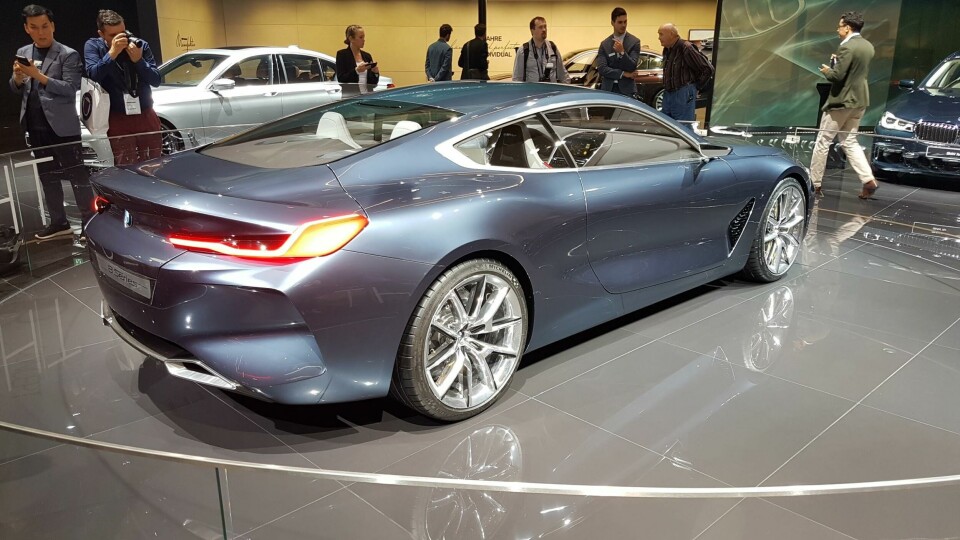
Frankfurt 2017: Marc Girard Explains BMW’s Design Language
BMW’s head of concept cars Marc Girard adds context to the 8 Series, Z4 and X7 gathered together for IAA Frankfurt
“We are launching a new design era at BMW,” says Marc Girard, BMW’s head of concept design, explaining that the Concepts 8 Series, Z4 and X7 are on show in Frankfurt “to display and pre-communicate the new form language of BMW, in exterior as well as interior design.”
Girard, who recently moved back to Munich from BMW’s Designworks studio in California, oversaw the 8 Series, Z4 and X7 programmes and says that while some earlier work on the 8 Series was done at Designworks, development has been ongoing in Munich.

For the Concept – first seen at Lake Como in May – “obviously we wanted to spice it up, but on the other hand, we do not want to disappoint our customers when the production car hits the road and they say oh, the show car was so much better!” Girard laughs.
“So we are really balancing, finding the sweet spot between enhancing the emotionality a little bit for the concept car but forecasting the real car – and I have to say that those three concept cars are close to what you are going to see on the road.”

As the first expression of BMW’s new ‘precision and poetry’ design language, the 8 Series sets out the new agenda. “We are reducing complexity, we are enhancing simplicity, we do more with less,” Girard explains. “To depict that, there are very few lines on the bodyside, but those lines are much stronger: they have much more precision.”
“On the other hand, the form language of the bodyside is [also] extremely emotional: very strong shoulders, and you have a lot of light in, light out, shadows and light casting on the bodyside. That’s what we call ‘poetry’, and the combination of both is basically the new BMW design.”

This translates inside, too, Girard adds: “The reduction process we went through for the exterior, we did that for the interior as well. You will notice that the overall volumes are a little bit more monolithic, they are a little bit simpler, they are more of a clear gesture…”
“In the centre console there are far fewer buttons and switches than before; we already took a lot out for the iDrive concept launched years ago, but here we go the next step, because cars are getting far more intelligent, therefore you need fewer switches to operate them, and if you have fewer switches, the overall appearance is going to look simpler.”

Against this cleaner backdrop, he notes, particular attention is paid to the quality of the detailing (which, for the Concept 8 Series, includes the application of Swarovski crystal to the trim).
The architecture is adapted for each of the vehicles, Girard explains. “The 8 Series is a gentleman driver’s car; it’s a sports car and a luxury car at the same time, so the centre console is very strong – we have a very powerful drivetrain in the car, and we want to display this.”
“For other cars like the X7, it has a lot to do with roominess, both perceived roominess and architectural roominess, and you’re going to notice that the sense of space in the X7 is much grander.”

However, “the most common thread for all of them, from an interior design perspective, is that they are all driver-oriented: that’s the same. The way we translate that is very different, very specific to each chapter of our portfolio, but the common path between all three of them [8 Series, Z4, X7] is that they are all driver-oriented. That is what BMW is all about.”
A further bond between all three of these concepts, and an approach taken with the new design language, is a growing linkage between interior and exterior design. “Our goal is to not have the interior being a kind of standalone item built within an exterior design, Girard says.

“I think probably the most visible approach is on the Z4, where we are enhancing driver orientation with this black-surrounded cockpit – it’s very radical, the colour and trim concept is there to enhance the driver orientation, and you see especially on this car this kind of symbiotic approach between exterior and interior where things are really getting together.
“On the 8 Series it’s maybe a little bit less obvious – it’s a coupé, not a convertible or roadster [where you can see inside from outside] – but the headlamps, for example: the headlights on the 8 Series have these very architectural, graphical elements, they’re not round anymore. They’re like fractals, and you can see exactly this pattern on the instrument cluster.

“The X7 goes a different way: if you look closely at the black leather upholstery, in the dark interior, it has a very subtle metallic reflex [shimmer], a kind of gold reflex in the leather which captures the gold reflex we have in the exterior colour. So here you connect interior and exterior in a different way – it’s very subtle because it’s very luxurious.”
Girard notes that some of these details are “second-read”, or subtleties not necessarily obvious at first glance. However, in the context of BMW’s vastly complex and diverse range of vehicles, the approach across these three concepts of very different vehicle types – 8 Series grand tourer, Z4 roadster, X7 premium SUV – does at least suggest renewed attention to design coherence and shared identity.



